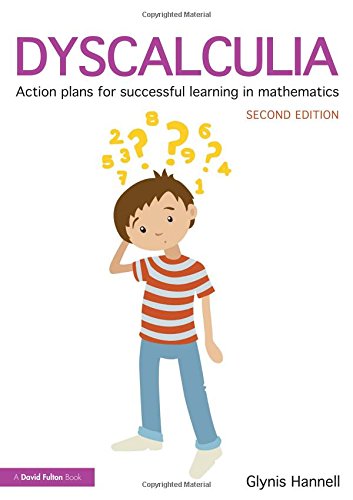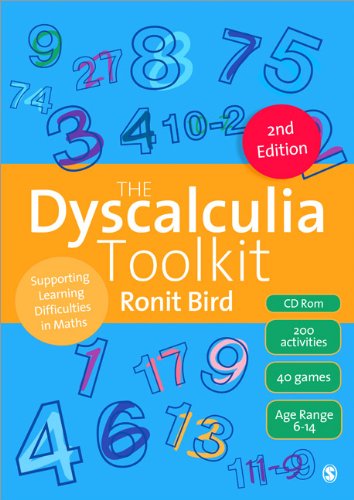Dyscalculia is difficulty in learning or comprehending arithmetic, such as difficulty in understanding numbers, learning how to manipulate numbers, and learning facts in Mathematics. It is generally seen as a specific developmental disorder like dyslexia.
Dyscalculia can occur in people from across the whole IQ range, often, but not always, involving difficulties with time, measurement, and spatial reasoning. Estimates of the prevalence of dyscalculia range between 3 and 6% of the population. A quarter of children with dyscalculia have ADHD.
Mathematical disabilities can occur as the result of some types of brain injury, in which case the proper term is acalculia, to distinguish it from dyscalculia which is of innate, genetic or developmental origin.
Dyscalculia has been associated with female children who have Turner's Syndrome.
History

Mental disabilities specific to mathematics were originally identified in case studies with patients who suffered specific arithmetic disabilities as a result of damage to specific regions of the brain. More commonly, dyscalculia occurs developmentally, as a genetically linked learning disability which affects a person's ability to understand, remember, or manipulate numbers or number facts (e.g., the multiplication tables). The term is often used to refer specifically to the inability to perform arithmetic operations, but it is also defined by some educational professionals and cognitive psychologists such as Stanislas Dehaene and Brian Butterworth as a more fundamental inability to conceptualize numbers as abstract concepts of comparative quantities (a deficit in "number sense"), which these researchers consider to be a foundational skill, upon which other mathematic abilities build.
Etymology

The term dyscalculia dates back to at least 1949.
Dyscalculia comes from Greek and Latin which means: "counting badly". The prefix "dys" comes from Greek and means "badly". "Calculia" comes from the Latin "calculare", which means "to count". The word "calculare" comes from "calculus" (the diminutive of "calx", which means stone), which means "pebble" or one of the counters on an abacus.
Problems with counting

The earliest appearance of dyscalculia is typically a deficit in the ability to know, from a brief glance and without counting, how many objects there are in a small group (see subitizing). Human adults can subitize 3 or 4 objects. However, children with dyscalculia can subitize fewer objects and even when correct take longer to identify the number than their age-matched peers.
Other problems

Dyscalculia involves frequent difficulties with everyday arithmetic tasks like the following:
- Difficulty reading analog clocks
- Difficulty stating which of two numbers is larger
- Inability to comprehend financial planning or budgeting, sometimes even at a basic level; for example, estimating the cost of the items in a shopping basket or balancing a checkbook
- Difficulty with multiplication-tables, and subtraction-tables, addition tables, division tables, mental arithmetic, etc.
- Difficulty with conceptualizing time and judging the passing of time. May be chronically late or early
- Problems with differentiating between left and right
- Inability to visualize mentally
- Difficulty reading musical notation
- Difficulty navigating or mentally "turning" the map to face the current direction rather than the common North=Top usage
- Having particular difficulty mentally estimating the measurement of an object or distance (e.g., whether something is 10 or 20 feet (3 or 6 meters) away).
- Inability to grasp and remember mathematical concepts, rules, formulae, and sequences
- Inability to concentrate on mentally intensive tasks
- Low latent inhibition, i.e. over-sensitivity to noise, smell, light and the inability to tune out, filtering unwanted information or impressions. Might have a well-developed sense of imagination due to this (possibly as cognitive compensation to mathematicalâ€"numeric deficits)
- Mistaken recollection of names. Poor name/face retrieval. May substitute names beginning with same letter.
Search for causes

Researchers consider dyscalculia to be akin to dyslexia, regarding it as a specific learning disability involving intrinsic and extrinsic properties.
Scientists have yet to understand the causes of dyscalculia. They have been investigating in several domains.
- Neurological: Dyscalculia has been associated with lesions to brain such as the Brodmann area 40 and angular gyrus at the junction between the temporal and parietal lobes of the cerebral cortex.
- Deficits in working memory: Adams and Hitch argue that working memory is a major factor in mental addition. From this base, Geary conducted a study that suggested there was a working memory deficit for those who suffered from dyscalculia. However, working memory problems are confounded with general learning difficulties, thus Geary's findings may not be specific to dyscalculia but rather may reflect a greater learning deficit.
Other causes may be:
- Short-term memory being disturbed or reduced, making it difficult to remember calculations.
- Congenital or hereditary disorders. Studies show indications of this, but the evidence is not yet concrete.
- Gerstmann syndrome: dyscalculia is one of a constellation of symptoms acquired after damage to the angular gyrus.
Involvement of the intraparietal sulcus has been suggested.
Treatment

Software intended to remediate dyscalculia has been developed.
Forms of educational therapy, such as neuro-sensory educational therapy, can be an effective treatment.
A study used transcranial direct current stimulation (TDCS) to the parietal lobe during numerical learning and demonstrated selective improvement of numerical abilities that was still present six months later.
